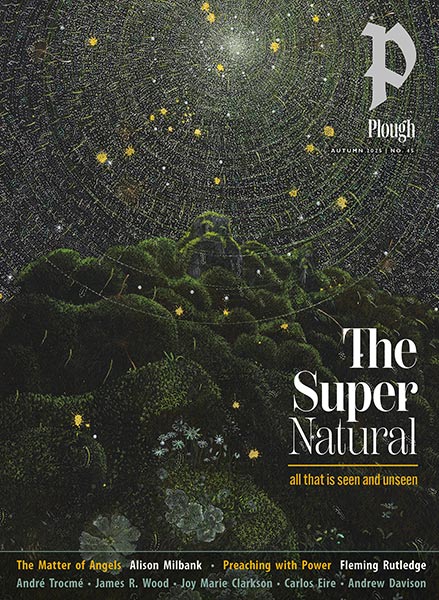Subtotal: $
Checkout
With the Zabbaleens of Mokattam Village
A visitor finds Christianity thriving on a garbage dump outside of Cairo.
By Martin Mosebach and Alta L. Price
February 13, 2025
From The 21: A Journey into the Land of Coptic Martyrs by Martin Mosebach, translated by Alta L. Price.
Until recently Cairo had no municipal waste collection, and yet the trash was disposed of – for the most part, at least. There was just enough left that you would never accuse the city of being overly hygienic. Donkeys laden with garbage bags trotted through the streets, and the odors trailing behind them betrayed the contents. The smell of trash is different from the venerable stench of latrines and tanneries – it’s a smell that doesn’t naturally exist, reeking of smeary plastics, of deathly dust and sterility.
Although municipal garbage trucks now make the rounds, the rickety old donkey-drawn carts haven’t entirely disappeared. Little boys steer them through dense traffic, taking visible joy in weaving between buses and trucks, and dodging the black plumes of diesel exhaust. Some even go on foot, carrying bags bigger than their own bodies, crammed with empty bottles and crumpled-up snack bags. Their destination is a neighborhood bordering the desert sands, near the old citadel, at the foot of the mountains. Muslims refer to this range as the Mokattam, or “broken mountain,” because, as legend would have it, this massif looming over the city was not always located on this spot.
As their simple language suggests, Coptic Christians love to interpret holy scriptures quite literally. What justifies theologians in categorizing Jesus’ every provocation as unlikely, symbolic, or allegorical, anyway? “Truly I tell you, if you have faith as small as a mustard seed, you can say to this mountain, ‘Move from here to there,’ and it will move. Nothing will be impossible for you.” In the year 975 these words of Christ, as recorded in the Gospel of Matthew, triggered a dispute between the vizier of the Fatimid caliphate and Ebn-Zaraa, Pope Abraham of Alexandria. The caliph settled the theological debate on his own: either the pope would successfully prove the truth of this promise or he would be beheaded. The pope requested three days to fast and pray, and was granted them. As he prayed, the Blessed Virgin appeared to him in Saint Mary’s Church El-Mu’allaqah, the “Hanging Church,” above the Babylon Fortress of Old Cairo, and ordered him to seek out a one-eyed man. The one-eyed man was found, and became known as Simon the Tanner. Simon, too, had chosen to take the Gospels literally and – in obedience to another of Jesus’ statements, also recorded by Matthew – had gouged out his eye because it had “caused him to stumble.” No one had a greater right to remind God of his promise than someone who had inflicted such harm to his own body out of reliance on scripture. Upon Simon’s prayers, and after the pope had given his blessing, the Mokattam Mountain rose three times and moved three kilometers, finally landing in its present location. On the way, it broke into three parts.
The fractures that attest to its migration are easily recognizable. Early on, in a grotto high as a cathedral, a small Marian shrine was built to commemorate the mountain’s miraculous relocation. But it was only in the twentieth century that the mountain, grotto, and sandy region that spread out before it became a center of Coptic life – and at the same time a symbol of the misery and splendor of the Coptic faith in its astonishing perseverance on the dark side of history.

Zabbaleen children ride a cart past burning garbage, City of the Dead slum, Cairo Egypt, 1989. Photograph by Barry Lewis / Alamy Stock Photo.
When people talk about Copts, they seldom neglect to mention their wealth. Yes, there are some very wealthy Coptic families. And in proportion to their small number, their share of the national wealth may be astonishing or revolting, depending on how one feels about them. Copts earned handsomely under the British Protectorate, in particular, because the colonial rulers preferred to rely on fellow Christians. But most Copts are not rich, and many are poor. The five thousand peasant Copts from Upper Egypt and the Faiyum Oasis who moved to Cairo together in 1960 – several large extended families in search of a livelihood – were not just poor, they were destitute. But they had not lost their resourcefulness. No one had been waiting for them in Cairo; they had to look out for themselves and learn how to get by in the jungle of the already wildly growing metropolis. They raised swine, the very embodiment of impurity according to Muslim and Jewish dietary laws, proving that the traditional ban on pork is not, as is commonly thought today, due solely to the hot Middle Eastern climate. It might not have been easy for unwelcome people to find food in Cairo, but it was easy to raise pigs on the city’s garbage.
Thus the rural emigrants became zabbaleen – literally “garbage people” and, by extension, “garbage collectors” – and filled an urgent need in the urban community. As in ancient times, men and boys scavenged for and collected the garbage, and women and girls sorted it. Then the famous singer Umm Kulthum, annoyed by the piles of garbage accumulating around her villa – who could blame her? – asked President Nasser, one of her many devotees, to expel the zabbaleen. It was on his orders that they moved to the outskirts of the city, where the miraculous broken mountain now rests. There was no running water or sewage system there, but that didn’t intimidate the frugal newcomers. The land surrounding the rocky outcrop was incredibly inhospitable, yet at the same time the blessed mountain made it holy terrain.
There are now eighty thousand people living there. Their houses have six floors. At ground level, the open floor plan facilitates the careful sorting of the collected garbage, which is tied up into big bales. The stench is breathtaking, though luckily, smells are one of the few unpleasant things one quickly gets used to. And smack in the middle of these garbage heaps lie the butcheries, complete with skinned sheep on open-air display. The fact that Saint Simon, a man employed in the foul-smelling tannery trade, became the patron and protector of this settlement seems fitting enough.
There is no way to gloss over it: Mokattam is a hideous place, and the awe that its gloomy, underworldly aspects inspire is of an infernal sort.
Following a 2009 swine flu outbreak, the city culled all extant herds and prohibited citizens from raising pigs – though as with most administrative measures in Egypt, enforcement was haphazard, and the results predictable. In other words, there are still plenty of pigs, now kept mainly in basements or on rooftop terraces. Still, because of the narrow streets and tall buildings the air is so thick that it made me not only want to flee, but also change my clothes as soon as possible. There is no way to gloss over it: Mokattam is a hideous place, and the awe that its gloomy, underworldly aspects inspire is of an infernal sort.
On that note, one cannot forget that this neighborhood, a city unto itself, has long been a symbol of the boldness and valor bestowed on its people by their considerable degree of success. I didn’t fully understand this until I followed a narrow road full of potholes and putrid puddles to where it led through a gate onto the rocky plateau spreading out under the jagged rock wall towering above.
Here a surprise awaited me: my surroundings had suddenly changed from hell to heaven. Beyond the narrow access road, a vast expanse opened up onto an endlessly broad panorama. Below me the tall houses of the so-called garbage village leaned toward one another, each crowned by precarious-looking scaffolding supporting a little hut – the pigeon loft.
Pigeon keeping is a common hobby among Egyptian peasants, and these rural people brought the practice into the city with them. Just as in ancient Greece, where doves and pigeons were considered the birds of Aphrodite, here, too, they are highly sought after as an aphrodisiac. (At rural weddings neighbors traditionally bring fifty roast pigeons stuffed with rice, with which the bride and groom are then locked up for three days!) Above the pigeon lofts, huge flocks fly in circles against the rosy sky until their respective keeper whistles a unique tune to summon
them home.
Turning away from these bizarre bird-filled towers, I spotted the Monastery of Saint Simon the Tanner. One in a series of cave churches in the rock wall, its entrance looks like a gaping mouth of stone leading into the depths. Here, over the last few years, half in the open air and half in the mass of rock, a church that holds several thousand people has been built. As in ancient Greek theaters, the seats take the shape of a large shell, and where the skene would have been stands an iconostasis closing off the rest of the cave. The altar is hidden deeper inside the mountain, behind a red velvet curtain. It is a place of miracles and apparitions: one small cave contains the wheelchairs of the many paralytics who have been healed here, and above the iconostasis a bas-relief of the Virgin with the infant Jesus, made by no human hand, has been discovered; it has since been reworked by a Polish sculptor. Here, again, I couldn’t help but notice how little the Copts care about documenting or preserving original, authentic phenomena. In a world made entirely of miracles, you don’t have to depend on any one manifestation for very long: you can be confident that the next one is soon to come.
The cave churches of Mokattam are the site of weekday prayers held to support the exorcism of the possessed and mentally ill. The task of expelling evil spirits – one of the first Jesus gave to his church, and one that is mostly treated as a source of embarrassment in the Western world – is understood here, as in the Gospels, as one of a priest’s primary duties. Several priests in black cassocks perform this service in the cave churches, which now have their own bishop; in fact, the garbage village has since been elevated to a diocese. After all, it has grown from a wild settlement of wretched huts into a thriving district so well organized that it sells its sorted garbage to China. A second, completely closed-off cave has become a meeting hall that can seat hundreds of people; instructing the laity is another important mission of the modern Coptic Church, and yet another point of a difference with the Western church, which seems to have given up the task of religious education as readily as it has the expulsion of evil spirits.
To me, the history of the zabbaleen in the holy cave seems a good example of the Coptic Church’s resurgence in the twentieth century. Are not the garbage-collecting boys, their skin so thoroughly steeped in dirt that no brush could ever clean it, a symbol of the hopeless position the Copts have often found themselves in after 1,400 years of oppression, and the exhaustion of their very last resources – but also of their resilience? Without that, how would it ever have been possible for them to regroup, summon what little strength remained, and mobilize their once-formidable forces?
An outsider’s eye might allow him to discover many things hidden from (or simply invisible to) an insider, but it certainly doesn’t help him assess the amount of energy that lies dormant at the core of such a movement. Even less so if, compelled by earthly logic, he feels obliged to exclude supernatural sources of strength as an explanation. Arching high above the vast neighborhood of trash, hasn’t this enormous old cave and its supposedly miraculous powers already brought the zabbaleen success? Once a neglected space, it now hosts plentiful flocks of pilgrims – a transformation that directly results from the massive increase in the Coptic population at the foot of the cliffs. The image of the Virgin lay dormant in the rock for more than a millennium before it was discovered, and over that millennium, the Copts became fewer and fewer, poorer and poorer, ever weaker and more despised. Without any rights or privileges, they endured and eked out an existence on the margins of Muslim society. They were an uneducated, obscure lot. And no Copt who has studied the historical facts cares to recall just how far back that condition stretches in time. Of course, a community’s view of political history and science as irrelevant also has its advantages …
The power exerted by the Blessed Virgin and Mother of God in Mokattam also has a highly protective function. One can view the rocky terrain above the city not only as a sanctuary, but also as a fortress. Few fighters could ever make it through the narrow entrance of its stone gate. Every now and then along the way there, the young men leading me pointed out how well the place could be defended from attack. True, the Pope of Alexandria and his bishops regularly urge their flocks not to reciprocate violence with violence. But the words of Mokattam’s young Copts suggest that they are determined not to accept any more persecution without putting up a good fight.
Already a subscriber? Sign in
Try 3 months of unlimited access. Start your FREE TRIAL today. Cancel anytime.








Jeremiah Robinson
What a beautiful account. Thank you!